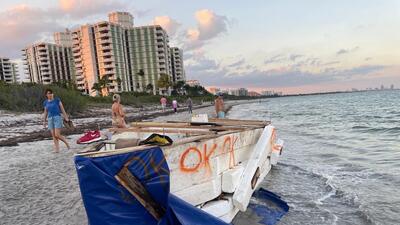US officials report massive increase of Cuban rafters in Florida waters

A rustic, polystyrene-built raft washed ashore on a Miami area beach Saturday in the latest evidence of a major increase in illegal seaborne migration from Cuba, according to officials.
There were no passengers on board but signs that the unknown occupants had traveled from Cuba which is in the midst of its worst political and economic crisis in three decades with shortages of basic items and island-wide power cuts.
An empty 50 kg sack of Uruguayan rice lay on the floor of the vessel, with lettering in Spanish saying it from the Cuban state import company, Alimport. There were also discarded sneakers, clothing and large water containers.
The vessel was discovered on a beach in Cape Florida State Park, Key Biscayne, about 7 miles from downtown Miami.
An engine, from a car or truck with a drive shaft connected to a propeller was installed in the center of the narrow 18-foot-long raft made from blocks of polystyrene riveted together with metal screws, wooden planks and industrial glue.
Record numbers of Cubans leaving the island
Historic numbers of Cubans – more than 250,000 - have abandoned the communist-run island over the last year. Most travel via charter flights to Nicaragua and then overland to the US border, according to U.S. government data. That more than 2 percent of the island’s 11 million population.
Although the number of those intercepted at sea has not reached the peak of the famous 'raft crisis' of 1994, it appears to be growing.
Most Cubans who are intercepted at sea are quickly repatriated to Cuba unless they can provide a compelling case of political, religious or gender persecution. The U.S. Coast Guard reported on Saturday that 152 Cuban refugees were re-patriated back to their homeland after five vessels had recently been intercepted off the Florida Keys.
Since October 1, Coast Guard crews have encountered 2,982 Cubans, almost half the total for all of the previous fiscal year, and twice the entire number for the previous four years combined between 2018 and 2022.
The Miami sector of the United States Customs and Border Protection also on Monday reported a 330% increase in smuggling events compared to last year. Migrant landings were also up 500%. It reported more than 20 migrant boats illegally reaching shore in the Florida Keys in the last two weeks, involving more than 520 Cubans.
U.S. and Cuba agree to fully resume existing immigration agreement
Under an existing migration accord, Cuba recently agreed to deport Cubans who illegally migrate to the United States. But so far no deportation flights have taken place. In exchange, the U.S. has agreed to resume processing family reunification visas at the U.S. consulate in Havana as of January 4, 2023.
In the case of the polystyrene vessel in Key Biscayne, orange letters "OK" spray painted on its side panels indicated that the U.S. Coast Guard had intercepted the vessel before it reached a beach in Cape Florida State Park, Key Biscayne, which sits about 7 miles from downtown Miami.
The U.S. Coast Guard's 7th District in Miami said photos of the raft taken by Univision indicated the vessel was similar to an overhead photo of an empty raft taken by a Customs and Border Protection Air and Marine Operations aircraft crew on Nov 25 off the Florida Keys.
“We searched for missing people in the water and did not find anyone, so we suspended the search," Petty Officer Nicole Groll told Islander News in Key Biscayne.
"It's the dangers of crossing the sea, like finding a needle in a haystack," Groll said. "The problem is, you never know who we are not finding. And we don't know who (or how many) was on there. That's the tragedy of what's happening with illegal migration."
At least two of the water containers were almost full, indicating that the passengers could have been rescued by passersby or smugglers.
"We try to investigate cases like that but the hardest thing is finding the smugglers," said Adam Hoffner, spokesman for Customs and Border Protection (CBP). "We investigate cases of human trafficking because they are exploiting these people," he added.



